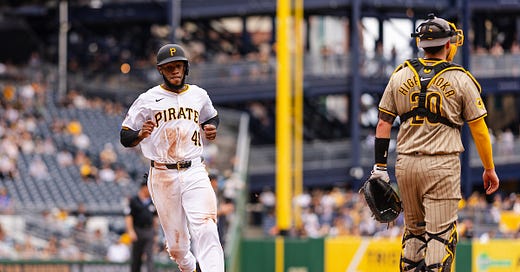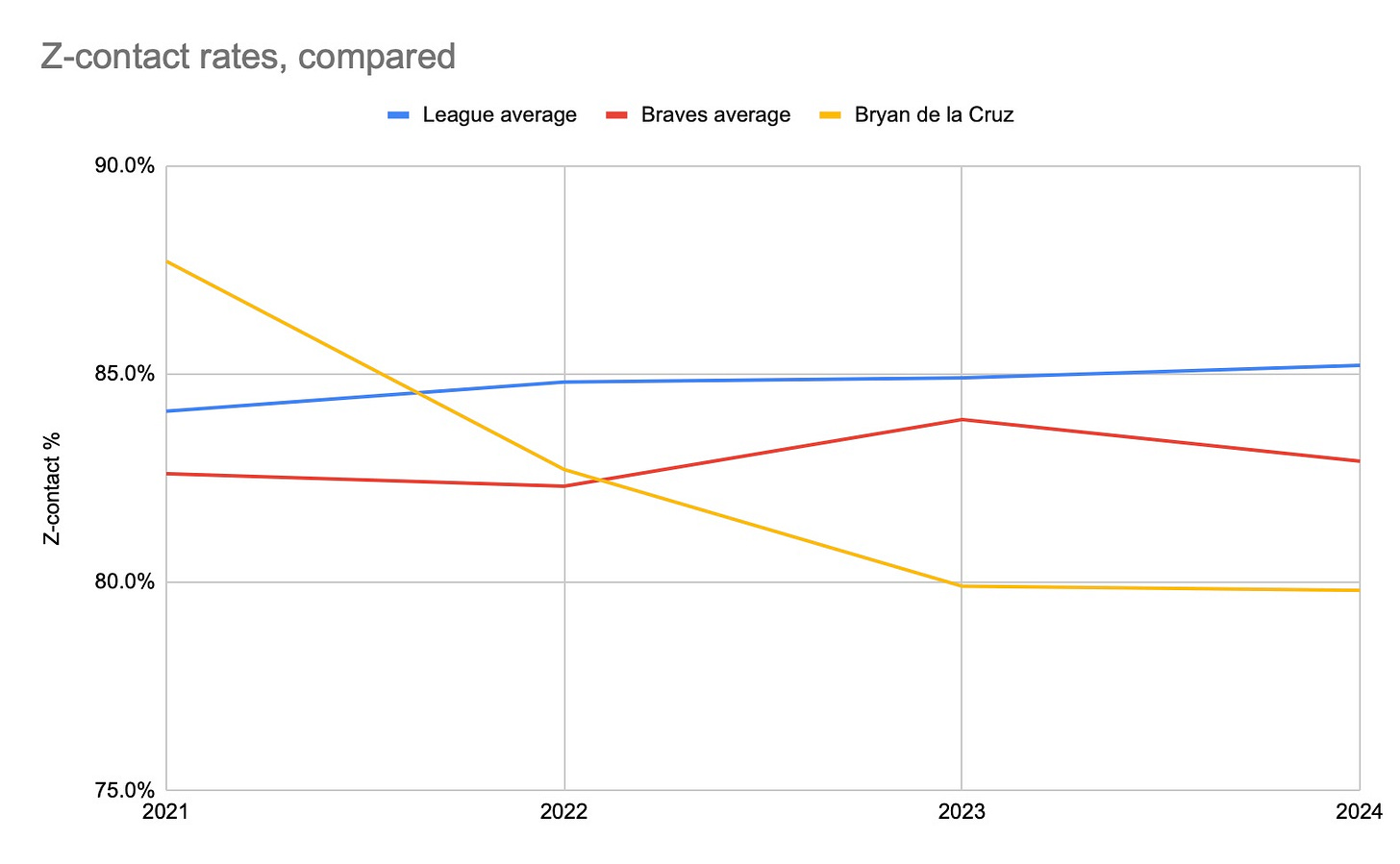Bryan de la Cruz: probably bad, definitely interesting
If de la Cruz has only one fan, then it's not me. But let's talk about him anyway.
In 2023, the worst qualifying hitter in baseball by fWAR was Jurickson Profar. Profar put up an atrocious -1.6 fWAR in 521 plate appearances and had to settle for a $1 million deal with the Padres the next year. Then he changed everything about his offensive ball-in-play profile and won himself $42 million.
The Braves clearly believe in Profar’s swing changes, given that he just got the second-biggest Braves free agent contract in the Anthopoulos era. But it’s almost a certainty that the Braves will not get as much surplus value from Profar over three years of this deal as the Padres got in one. FanGraphs’ player pages quantify player performance in dollar value, pricing 1 fWAR at about $8 million. By their numbers, Profar delivered $34.4 million of value on a $1 million contract - or $33.4 million in surplus value. For Profar to provide that kind of surplus value to the Braves, he’d have to be a shade better than 3 fWAR annually - or, put another way, he’d have to deliver the second-, third-, and fourth-best seasons of his career as he slides down the aging curve.
This isn’t to say that I don’t like the Profar acquisition. Definitionally, any amount of surplus value on a free agent contract is a win; Profar could simply be a 2-fWAR player annually and more than earn his contract. My point here is that when it comes to value, there’s no substitute to finding - or molding - a breakout star yourself.
In 2024, the worst qualifying hitter in baseball by fWAR was Bryan de la Cruz. de La Cruz accumulated -1.2 fWAR between a bad spell with the Marlins and an unspeakably bad 44-game stretch with the Pirates in which he hit to a 27 wRC+1 and generally looked unplayable.
There are some clear differences between Profar and de la Cruz. Profar was a former top prospect in the sport who had posted multiple good campaigns (if not any great ones), including one in 2022, whereas de la Cruz was a fringe prospect and is yet to eclipse the 1-fWAR mark in a season. de la Cruz is three years younger than Profar was last offseason, was obtained on a minor-league deal, and even has an option. But there are also some parallels beyond their worst-player-in-baseball titles - each is a bat-only corner outfielder with one promising element and one crippling flaw in his offensive profile. If you’re looking for Jurickson Profar Before He Was Cool, de la Cruz checks a lot of boxes.
Much has been written about why the Braves spent $42 million on Profar. Let’s talk about why they’re taking a chance on de la Cruz.
What de la Cruz can (and can’t) do
Here’s a big difference between Profar and de la Cruz. Profar has always posted good strikeout and walk numbers; his struggle for years was making quality contact. During the Statcast era, the leaguewide xwOBA for balls in play (or xwOBAcon) is .368. 2024 was the first time in Profar’s career that he’s surpassed that mark. On the other hand, even looking past his excellent 2022 campaign (in which he posted a .458 xwOBAcon, in the 96th percentile), de la Cruz put up a .405 xwOBAcon in 2023 and a .396 xwOBAcon in 2024.
The trouble for de la Cruz is poor strikeout and walk numbers, driven by high chase and whiff rates. The natural reaction to a player like that is to conclude that he has no plan (or at least a bad plan) at the plate. But the funny thing is that de la Cruz’s swing decisions aren’t so bad. Sure, the chase rate has always been poor, but swing decisions are about more than laying off balls; they’re about swinging at strikes, too, and de la Cruz is excellent in that regard. Baseball Prospectus has developed a swing decision metric known as SEAGER, which “attempts to reward hitters not just for spitting on the pitches they should, but also for not letting pitchers sneak pitches by them in areas and counts where they can do damage.” The Braves love SEAGER darlings; Ozzie Albies, Jarred Kelenic, and Sean Murphy2 were the only Braves regulars who finished with below-average SEAGER scores in 2024, while Marcell Ozuna was in the 100th (!) percentile. de la Cruz finished above the 80th percentile in SEAGER in 2021, 2022, and 2023, and was in the 78th percentile when he was traded to the Pirates last year. He then collapsed to the 40th percentile there; add that to the list of things (everything?) he got worse at in a Pittsburgh uniform.
So good things happen when he puts the ball in play and for three and a half years, he made good swing decisions. What’s the problem?
The problem is that de la Cruz really struggles to make contact in the strike zone. (Contrast this with contact out of the strike zone, where de la Cruz is actually average or better.) That isn’t automatically cause for alarm; from 2019 through 2024, the Braves had the lowest zone-contact rate (i.e. they whiffed at the highest percentage of strikes) of any team in baseball and the fourth-lowest contact rate overall. This is part of the team’s philosophy; you only get one ball in play per at-bat, so take big swings at hittable pitches, keeping in mind that a swinging strike in a zero- or one-strike count is better than a poorly-hit ball. But the Braves’ (dead-last) in-zone contact rate was 83 percent, and de la Cruz hasn’t even hit the 80 percent mark the last two years!
As you can see, the gap between the current iteration of de la Cruz and the lowest-in-the-league Braves is greater than the gap between the Braves and the league average.
There are a few hitters who have survived, or even thrived, with such a low in-zone contact rate; among others, Dansby Swanson, Aaron Judge, and Giancarlo Stanton have posted lower marks in the last few years. But Swanson and Judge are meaningfully more disciplined hitters than de la Cruz; their offensive value isn’t as dependent on connecting with strikes since they don’t waste as much time swinging at balls. Stanton is a closer comparison, but whereas de la Cruz is quite good when he puts the ball in play, Stanton’s among the very best in baseball.
So de la Cruz does a lot of things well offensively. Basically everything but the most important part, actually: making contact with the baseball when it’s in the strike zone.
What de la Cruz probably is
If de la Cruz can’t either meaningfully improve his chase rate or improve his zone contact rate without diminishing his ball-in-play profile (i.e., if he can’t get there without choking up in two-strike counts), he’s always going to be a boom-or-bust hitter, with a better chance of bust than boom in any given year. He’ll run into some home runs if given playing time - ZiPS projects him for 18 if given 564 PAs - but he’ll strike out a lot and his on-base profile will be almost entirely driven by batting average (which, for de la Cruz, is generally more fine than good).
To envision a dream outcome for Bryan de la Cruz, we don’t have to imagine him developing skills he’s never shown; we just have to look back a few years. In 2022, Bryan de la Cruz posted a .355 xwOBA over 355 PAs (no typos here). For reference, that was 25th best among qualifying hitters. de la Cruz had better inputs than Kyle Tucker, Matt Olson, William Contreras, Jose Altuve, Vladimir Guerrero Jr., and Mookie Betts, among others. Now, de la Cruz had some very poor luck (third-worst xwOBA underperformance of qualifying hitters, behind only Ryan ‘why is this left field wall so far away’ Mountcastle and Ronald Acuña Jr.), but over a meaningful sample, the inputs were real.
Want a more realistic outcome? de la Cruz has had a strong platoon split the last two years, hitting to a .343 xwOBA against lefties and a .308 xwOBA against righties. (This makes de la Cruz a better hitter against lefties in that span than Corey Seager, Jose Altuve, and Julio Rodriguez, among others.) Given that Jarred Kelenic has mostly put up strong platoon splits in the opposite direction, de la Cruz is a good candidate to be the weak side of a right field platoon - or at least a frequently used pinch-hitter for Kelenic - until Ronald Acuña Jr. returns.
The funny thing about being the worst qualifying hitter in the sport is it doesn’t necessarily mean you’re the worst hitter in the sport. Seven players were worth fewer fWAR than Bryan de la Cruz last year; it’s just that many of them got pulled well before they got anywhere near the qualifying threshold. (Particularly impressive is the -1.5 fWAR José Abreu accumulated in merely 35 games.) Being the worst qualifying hitter in the sport means you’re the worst hitter who someone still believes in.
There are worse players in whom to place your faith.
This Substack is free. Like my work? Please consider buying me a coffee here.
This is 19 points worse than Max Fried’s career average, which is both a sign of how atrocious de la Cruz was in Pittsburgh and a reminder that most ‘good’ hitting pitchers were still extremely bad hitters.
Murphy was well above average by SEAGER in 2022 and 2023, if you’re looking for more evidence that his oblique injury kept him from getting off the ground in 2024.






